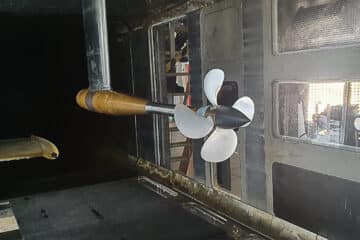Electromagnetic railguns are launchers using very high electrical energy by using the Lorentz force to obtain significantly higher initial velocities than those of chemical guns.
ISL is the leading Research institute in Europe in the domain of electromagnetic railguns. Initiated and lead by ISL, a consortium of several European partners (France, Germany, Poland, Italy and Belgium) has been formed named PILUM (Projectiles for Increased Long-range effects Using Electro-Magnetic railgun) and has applied successfully for a EDA-PADR (Preparatory Action on Defence Research) project. The result has been published by the European Defence Agency in April.
The EDA-PADR PILUM Project will cover a period of two years in order to show the feasibility to construct such an electromagnetic railgun for artillery applications which can reach standoff distances up to 200 km. A possible integration into ships and other military platforms shall also be investigated. Experimental, simulation and modelling work will be part of the studies to proof the feasibility for the use of theses railguns. These studies shall be the basis for the definite construction of a Demonstrator within a 8 years term.
PILUM Projectiles for Increased Long-range effects Using Electro-Magnetic railgun: Considering trends for enhanced precision and range of ammunition while seeking affordable costs, the electromagnetic railgun (EMRG) is a disruptive technology to launch projectiles over extremely long distance (more than 200 km) and a potential operational game-changer, thanks to electromagnetic acceleration instead of chemical propellants. The project lays the foundation for achieving a full-scale demonstrator by 2028
European Defense Agency
Existing railguns by ISL: PEGASUS and RAFIRA

ISL’s railgun facilities are unique in Europe and already features several railgun systems including:
The 10 MJ installation PEGASUS which is being used to advance the launcher and armature technology towards a reliable half-scale long range artillery system. Recent results include the successful launch of in-house developed launch packages (mass range is kg) for hypervelocity (> 2500 m/s) projectile acceleration. The ISL launch technology sets worldwide accepted standards with regard to the efficiency of the conversion of electric energy into kinetic energy (> 35%).
RAFIRA is a railgun (25 mm2 caliber) with which a salvo up to five shots can be launched at extremely high fire rates. In single shot mode, RAFIRA can accelerate projectiles in the mass range of 100 grams to velocities of more than 2400 m/s corresponding to acceleration levels of more than 100 000 g. This launcher is used to investigate the potential use of railgun technology for anti-ship missile scenarios. Operational research analysis has led to the conclusion that fire rates of over 50 Hz are necessary to defend against hypersonic Missiles.
The United States (Office of Naval Research, Naval Surface Warfare Center Dahlgren Division and BAE Systems), India (DRDO), the UK (DRA), Japan (ATLA), Russia as well as China all have electromagnetic railgun research projects at various stages of advancement. None so far has been fielded, but China appears to have conducted at sea tests of its prototype.






